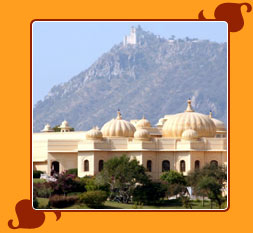The 'city of lakes'is perhaps the most romantic and
beautiful cities of India. In contrast to Its desert neighbourhood it stands
out with an enchanting image of white marble palaces, placid blue lakes,
gardens and temples surrounded by hills and mountains. It was founded by
Maharaja Udai Singh in 1559 AD on the shores of lake Pichola. The most
striking landmarks of the city are City palace and Lake palace. It developed
scientifically, the old city was surrounded by fortified bastions with entry
through 11 gates.

Ruins
of these fortifications are still there, and the more recent palaces can be
visited. In fact, a number of the former royal homes are now excellent
hotels, allowing you a glimpse into Rajasthan's princely life with all its
attendant splendors. Udaipur is known for its fairytale palaces that nestle
along the banks of a lake, or completely cover islands in its midst.The
Sisodia rulers of Chittaurgarh who ruled here obviously had more leisure to
exercise their taste than at Chittaur where much of their time was spent at
war. It situated on the edge of three lakes, its narrow streets lined with
shops and craftsmen's ateliers encourage hours of window- shipping for
tourists. Udaipur stands out for its heritage, crafts and performing arts
and its school of miniature painting is noteworthy.
Forts
& Palaces in UdaipurCity Palace: City Palace towers
over the Pichola Lake. Maharana Uday Singh initiated in the construction of
the palace but succeeding Maharanas added several palaces and structures to
the complex retained a surprising uniformity to the design. The entry to the
Palace is from the Hati Pol, the Elephant gate.
The Bari Pol or
the Big gate brings you to the Tripolia, the Triple gate. It was once a
custom that the Maharana would weigh under this gate in gold and silver,
which was distributed to the populace. It is also now the main ticket
office.
Jaswant Thada : Jaswant Thada in Jodhpur is a
white marble memorial built in memory of Maharaja Jaswant II in 1899 A story
goes that Maharaja Jaswant succumbed to injuries in this place while
fighting the Mughal king Jahangir. This place is a must visit in Jodhpur.
Fateh Prakash Palace: It's like being cocooned in
authentic royal luxury at the Fateh Prakash Palace, the grand heritage
palace of the HRH group. The warmth of royal hospitality greets you as you
walk along the corridors lined with large paintings of the Mewar school that
flourished in the seventeenth through nineteenth century.
The
Lake Palace:The Lake Palace is located on the Jag Niwas Island and
covers the whole of 1.5 hectare of the island in the middle of the Pichola
Lake. Built by Maharana Jagat Singh in 1743 it was meant as a royal summer
palace and now converted in to a five star palace hotel. It is a magical
palace and its image in the middle of the lake is like a leaf straight out
of a fairy tale book with an excellent taste of intricate craftsmanship and
the ethnic themes using the textiles and handicrafts all over highlight the
beauty that is simply beyond compare the lake around makes a pleasant murmur
with its rippling waves and lapping that adds to the mesmerising moments.
Monuments & Havelies in UdaipurBagore-Ki
Haveli: This is a very congenial old building built right on the
waterfront of Lake Pichola at Gangori Ghat. Amir Chand Badwa, the Prime
Minister of Mewar built it in the eighteenth century. The palace has over
hundred rooms and some very interesting display of costumes and modern art.
The glass and mirror in the interiors of the Haveli delicate work and well
preserved too.
Maharana Pratap Memorial: An impressive
bronze statue of Maharana Pratap and his favorite and loyal horse, who was
fiercely protective about his master and stood by him till his last breath,
stands at the top of Moti Magri (Pearl Mount) overlooking Fateh Sagar. Local
people climb the hill to pay homage to Rana Pratap and his faithful charger
'Chetak', who was killed in the battle of Haldighati. There are the ruins of
one of the first Udaipur's forts and there is also a charming Japanese rock
garden not faraway .
Museums in Udaipur City
Palace Museum: The main part of the palace is now preserved as a museum
displaying a large and diverse array of artefacts. Down steps from the
entrance is the armoury museum exhibiting a huge collection of protective
gear, weapons including the lethal two-pronged sword. The City Palace museum
is then entered through the Ganesh Deori meaning the door of Lord Ganesh.
Shilpgram Museum:Literally meaning a "Craftsmen's
Village" is a living ethnographic museum depicting the enormous
diversities in craft, art & culture between various Indian states, but
the exquisite terracotta work mainly in dark red and dark brown sand
material along with the wooden carvings are the forte of this ethnic village
. Shilpgram comprises 26 huts set in 70 acres of natural surroundings at the
foot of the Aravali Hills.A colourful craft festival during winter seasons
to the whole set up induces viatanity and zeal.
Ahar Museum:Located
about 2 kms east of Udaipur is an impressive cluster of cenotaphs of the
Maharanas of Mewar. There are about nineteen cenotaphs of Maharanas cremated
there. The most striking cenotaph is that Maharana Amar Singh, who reigned
from 1597 to 1620. Nearby is also Ahar Museum, where on display is limited
but very rare earthen pottery.
How to Reach Udaipur
Air: Debock Airport is 24 km from the city centre,
Dairy Indian Airliness flights connect Udaipur with Jodhpur Jaipur
aurangbad, Mumbai and Delhi.
Rail: Udaipur is
directly linked by rail with major cities some important train connection
are : 9643 Express (Delhi Sarai Rohilla-Jaipur-Ajmer-Chittaurgarh-Udaipur.)
Road: A wide network of bus service link Udaipur
with several destinations. Some of the important distance are Agra 630km,
Ahmedabad 262 km Jaipur 406 km .Jodhpur 275km and Mount Abu 185km. Local
Transport : Unmetered taxis, auto-rickshaws, tongas, city bus, regular city
bus service is available for dabok airport, badi Lake, Bedala and shaeliyon
ki Bari.






 Ruins
of these fortifications are still there, and the more recent palaces can be
visited. In fact, a number of the former royal homes are now excellent
hotels, allowing you a glimpse into Rajasthan's princely life with all its
attendant splendors. Udaipur is known for its fairytale palaces that nestle
along the banks of a lake, or completely cover islands in its midst.The
Sisodia rulers of Chittaurgarh who ruled here obviously had more leisure to
exercise their taste than at Chittaur where much of their time was spent at
war. It situated on the edge of three lakes, its narrow streets lined with
shops and craftsmen's ateliers encourage hours of window- shipping for
tourists. Udaipur stands out for its heritage, crafts and performing arts
and its school of miniature painting is noteworthy.
Ruins
of these fortifications are still there, and the more recent palaces can be
visited. In fact, a number of the former royal homes are now excellent
hotels, allowing you a glimpse into Rajasthan's princely life with all its
attendant splendors. Udaipur is known for its fairytale palaces that nestle
along the banks of a lake, or completely cover islands in its midst.The
Sisodia rulers of Chittaurgarh who ruled here obviously had more leisure to
exercise their taste than at Chittaur where much of their time was spent at
war. It situated on the edge of three lakes, its narrow streets lined with
shops and craftsmen's ateliers encourage hours of window- shipping for
tourists. Udaipur stands out for its heritage, crafts and performing arts
and its school of miniature painting is noteworthy.